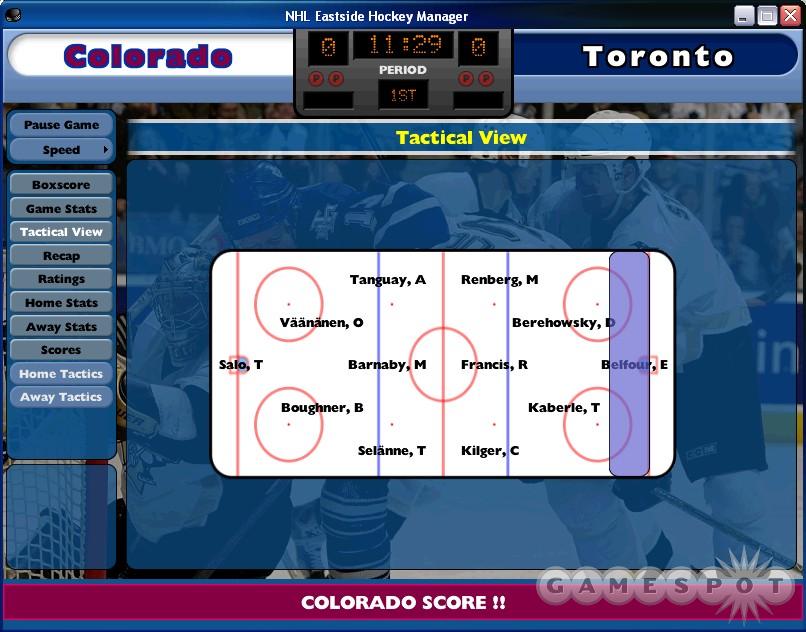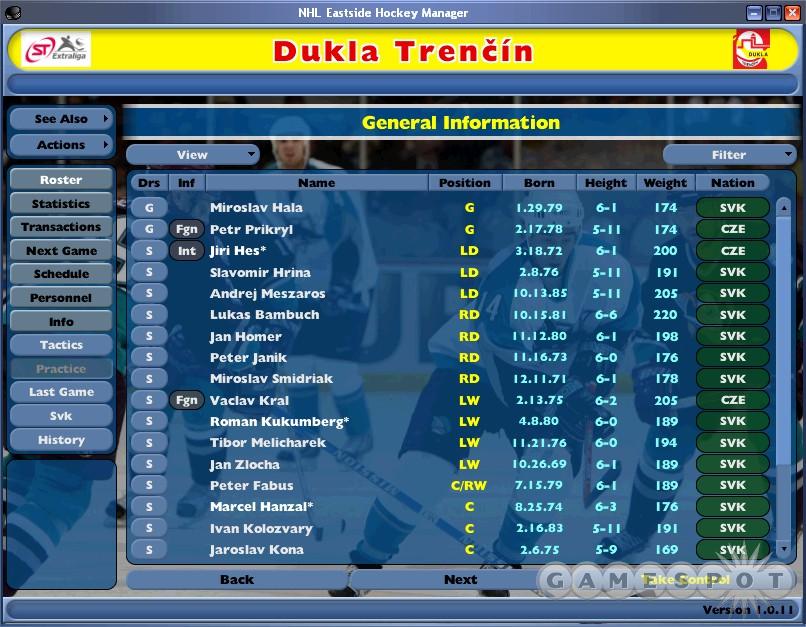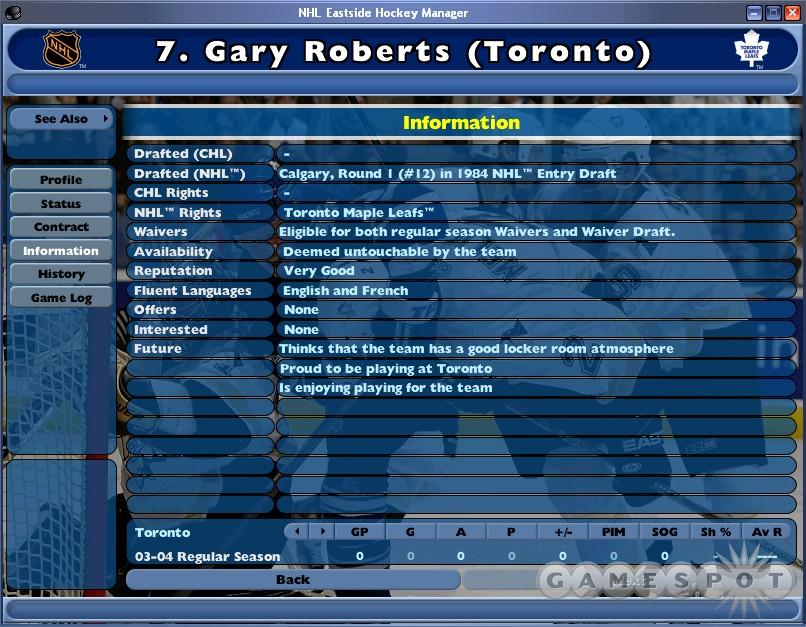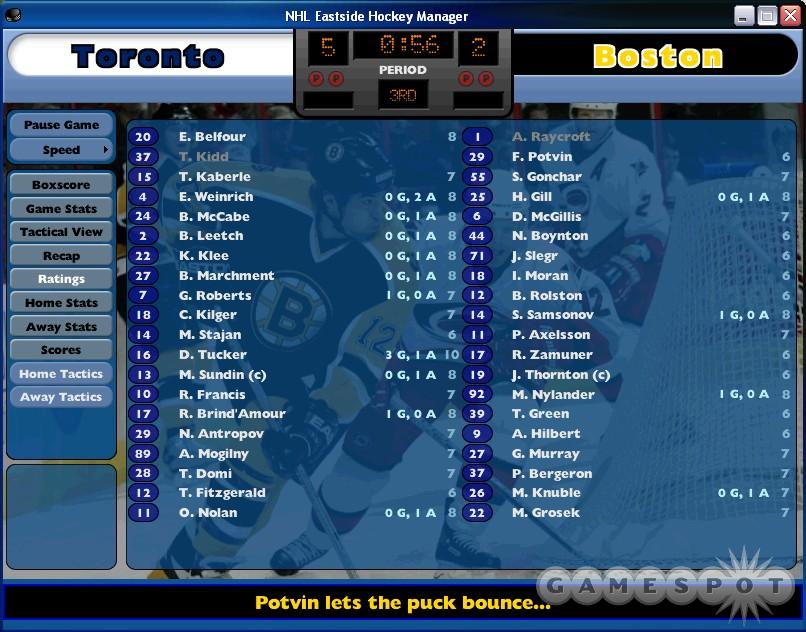Do Canadians really know hockey best? Finnish game developer Risto Remes and UK sports management sim legend Sports Interactive (best known for the Championship Manager series of soccer sims) are putting that platitude to the test with NHL Eastside Hockey Manager, the most comprehensive treatment of the coolest game on Earth ever seen in a game. This fantastically addictive management simulation covers the entire world of hockey, encompassing everything from tier-two Canadian Junior 'A' Hockey League clubs in small-town Saskatchewan to the bright lights, big city atmosphere of National Hockey League franchises like the New York Rangers.

Encyclopedic scope is Eastside's biggest plus. While designers have attempted NHL management simulations before, nobody has included so much hockey in a single game. Remes first released the game as downloadable freeware in 2001, and the amount of time that he's spent working on the project shows. Even though most will be drawn to the lineup of recognizable teams and players in the NHL, you can take over clubs in 18 leagues in every corner of the globe, in both solo and in online multiplayer leagues. You can head to the show right away and step in as general manager of famed teams like the Toronto Maple Leafs or the Chicago Blackhawks, or you can start farther down the line with a minor-league club like the Brandon Wheat Kings of the Western Hockey League. You can even leave North America altogether to sign up the likes of Dukla Trencin in Slovakia's ST Extraliga. Do well in the minors and you may just get an offer from one of the big boys.
Team and league listings are exhaustive. Even tier-two and tier-three Canadian Junior 'A' Hockey League and Canadian Junior 'B' Hockey League clubs are featured here, from tiny towns like Brockville, Ontario, to Pictou, Nova Scotia. Most teams feature a full complement of real players and management staff. In fact, there are more than a thousand teams and more than 20,000 players in the game. Even the majority of minor-league franchises boast accurate listings of personnel. For instance, you can even call up Major Junior teams--like those from the Ontario Hockey League in Canada--to see local legends like Brian Kilrea (the winningest coach in Junior hockey) running the Ottawa 67's or to see Jeff Twohey commanding the Peterbough Petes. Eastside is a licensed product of both the NHL and the NHLPA, too, so all of the familiar logos, names, and faces are on display here for that touch of big-league authenticity. If you know your hockey, you'll feel right at home here.
Of course, Eastside Hockey Manager is supposed to be a game, not an encyclopedia. Thankfully, Remes and Sports Interactive have remembered this and have combined the painstaking lineup of leagues, teams, and players with gameplay that serious hockey fans will find almost impossible to put down. A big part of this is because of the extensive player ratings system. Every player in the game comes rated in 27 skills that are divided into mental, physical, and technical categories. Every aspect of a player's personality and hockey abilities are tracked here, including aggression, teamwork, speed, checking, hitting, deking, stickhandling, and so on. The only omission is a plain English scouting report that puts all of these numbers into a concise paragraph detailing player strengths and weaknesses. You can request reports from coaches and physiotherapists, though. So at least you can get an expert opinion on whether or not a player is good enough for the starting lineup, or you can get advice about the condition of a player who's suffering from chronic injuries.
Players also come with reputations and opinions about their teams. So you might have a solid team player like Eric Desjardins, who believes that the Philadelphia Flyers have "a good locker room atmosphere." However, you may have an unhappy camper like Ed Belfour, who feels unfairly treated even when the Toronto Maple Leafs offer him a new $10 million-per-year contract. Some players are flat-out head cases who seem destined to rip up team chemistry. Mike Comrie, for instance, seems to alienate teammates in every dressing room he enters, just like in real life.

Players who are proud to be with their clubs are easier to re-sign, and they're easier to lowball with contract numbers. However, they can also react negatively to such maneuvers. Players sometimes have problems being shopped around the league, taking media criticism, enduring time on the bench, and so on, so their play suffers accordingly. Others might make friends on the team, so they may want out if their unofficial team "leaders" are traded or aren't re-signed. We had trouble in Toronto with Matt Stajan when Alexander Mogilny was allowed to leave town at the end of his contract, because Stajan felt that Mogilny was a key member of the club. All of these factors turn players into people, thus making it a challenge to set a coherent, winning lineup.
Money matters make it even harder to build a Stanley Cup contender. Your board of directors can keep a tight hold on the purse strings and can refuse to pony up the cash needed to re-sign pending free agents. Run a small-market franchise like Ottawa and caps on contracts for certain players can be so low that you simply can't sign them. There is no way around this, either. Your focus is solely on building a winning hockey club, so there are no moneymaking options--like raising ticket prices, staging promotion nights, or jacking up the price of beer--as in sports management franchises like Out of the Park Baseball and Baseball Mogul. You simply have to stay within the limits outlined by the board of directors, and you must do well in the amateur and waiver drafts.
Smart artificial intelligence provides you with tough opposition. Computer-controlled GMs can't be conned into dumb trades, because many top players are designated untouchable. This prevents human players from robbing computer opponents, but at the same time, it makes the game a little less realistic, because it's virtually impossible to convince your rivals to make a fair big-time swap. We couldn't get Joe Thornton away from the Bruins for the likes of Mats Sundin, Alexander Mogilny, and a first-round draft pick. Also, some odd players are designated untouchable. The ever-losing New York Rangers, for example, refuse to move Eric Lindros for equitable return, even though the real team managers would probably love it if some sucker would take his contract off their hands.

These opponents are also hard to beat on the ice. Computer coaches set up good lines and alter their approaches to best square off with your squad. Manually coaching games features a lot of options. Along with setting your lines, you can give the team orders that determine how your players forecheck, back-check, hit, and play the puck along the boards. You can even instruct your players to go high, low, or five-hole when shooting, and you can tell your goalie whether he should stay in his net or play the puck whenever possible. The success or failure of your orders can be seen played out on the game screen, which features serviceable, if not overly charismatic, textual play-by-play and a tactical option that shows the flow of the play on an ice surface viewed from above.
There are just a few flaws here, many of which concern the interface. As with a lot of text-based sports management games, the menu system could use a little work. Although the screens mimic a Web browser, the design often reverses what would be intuitive. For example, when you want to make a trade, you have to go to the information screen of the player in question to select the trade option from a list of available actions, instead of choosing to make a trade and then selecting the player you want to acquire.
A more serious issue is the locked-down database. As constructed right now, Eastside Hockey Manager allows no editing of player or team names, statistics, or individual characteristics. This is a significant problem, especially if you're a hockey nut who can't live with stat and character oversights. As with most sports games, there are a fair number of these issues here. Fortunately, the vast majority of these mistakes are minor boo-boos involving fringe players. So while there's no way that fringe Leafs grinder Clarke Wilm is half as aggressive as skilled superstar teammate Mats Sundin, it's not like very many people are going to care, since a good 80 percent of NHL player ratings are dead on target. Still, it would be nice if Sports Interactive (or even some enterprising modder) rectified this situation by adding a player editor.
Also frustrating is the absence of wide-ranging league-news reports. News about your own team is regularly presented, but there isn't much information offered up about other clubs in your league. Sometimes you feel as if you're playing in a vacuum. You hear the occasional trade rumor through the media, and you get the odd entertaining story about events like NY Ranger fans staging protests against team management after lopsided losses, but you have to manually sift through team rosters or use filtered database search functions to see if players are available for trade--if they're unhappy, injured, or so on. While this isn't difficult, due to a colorful icon system that lets you see a player's status just by looking at the main team roster screen, more news from around the league would be appreciated.
More happenings around the league would also be welcome. There often isn't a whole lot to report. Computer teams don't trade among one another very often, and the NHL trade deadline day tends to come and go without a whimper. Contrast this with the real NHL trade deadline, where a good two dozen deals are made in 24 hours, and you can't help but be disappointed. At least teams in the game sign their own players smartly and make intelligent choices during the amateur and waiver drafts.

Still, once you get used to the way that Sports Interactive has laid out the menu system, it's a snap to propose trades, set up lines, negotiate contracts, fire coaches, and so forth. And this is one of the most attractive sports management sims out there. Screens are colorful, varied, and feature a lot of player photos and team logos. Even the fonts here are interesting, because Remes has used a variation of the blocky Toronto Maple Leafs font for all letters and numbers. This might not seem like much of a stylistic innovation on paper, but it does manage to liven up what would normally be staid stat screens. Unfortunately, there is no audio to match this stellar visual presentation, even when manually simulating games.
Despite these issues, NHL Eastside Hockey Manager is manna for hockey fans. This is easily one of the best sports management games on the market, and it's second star only to Sports Interactive classics like Championship Manager.